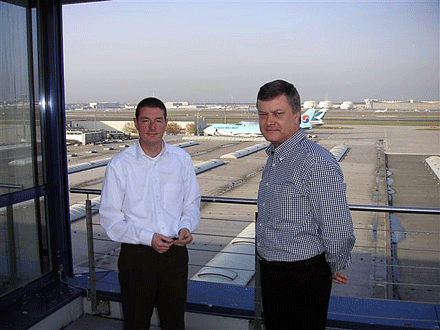
For
Chile, a country stretched almost 6,000 km long on the western side
of South America it was absolutely natural to employ airplanes as early
as they became available.
In March of 1929 LAN was founded and started
domestic flights.
The carrier grew fast and inaugurated
international flights to Argentina, the USA, Tahiti, Australia and the
Easter Islands before also conquering Europe with daily services to
Madrid and Frankfurt since 1980 that continue until today.
LAN actually incorporates a handful of
carriers based in several countries for obviously a number of practical
reasons – such as traffic rights for example.
But they all operate absolutely coordinated
under one star and gradually become full members of the expanding oneworld
alliance. The characteristic three letters with the silvery star originally
stand for “Linea Area Nacional - LAN”.
LAN acted fast after the Varig problems
last year.
The airline now connects Argentina and
the Brazilian key markets with high frequency.
The entire LAN fleet presently consists
of 70 airplanes including 36 from Boeing and 34 from Airbus with an
additional 24 on order from Airbus and 5 from Boeing.
LAN Cargo Holding is gathering all cargo
activities of the several national subsidiaries under one label that
operates as a highly independent division.
In Europe LAN management is located in
Madrid for the passenger business and in Frankfurt for cargo.
The organization is lean, efficient and
extremely successful.
 Room
with a view and things are looking up for Frank Hermann LAN Cargo sales
manager Europe (left) and Director Europe, Guido Henke at Cargo City
South Frankfurt.
Room
with a view and things are looking up for Frank Hermann LAN Cargo sales
manager Europe (left) and Director Europe, Guido Henke at Cargo City
South Frankfurt.
Guido Henke is LAN Cargo director for
Europe.
Frank Hermann looks after the commercial
part and Martin Rehs is head of operation. With the exception of Germany
and Spain LAN Cargo capacity is sold through a hand selected group of
GSSA's all over Europe. About 40 people cover the entire range of capacity
planning, customer service call centre, sales and GSSA-steering, operations
and accounting.
A high degree of attention is given to
optimizing the on load on pallets and containers – the operations
group is after every kilo – the philosophy is that 1,500 kilos
left behind are a waste of more than 3,000 Euro. The respective weights
are carefully registered with underloads rigorously recorded and reviewed
– daily, weekly, monthly.
The overall impression here at FRA is
that the spirit among the very young crew of 30 is excellent.
All speak Spanish of course and many bring
some international touch into the daily work like the boss himself who
is a German who grew up in Argentina.
With estimated 29,500 tons carried out
of Europe, the region contributes a solid 23 % to the carrier’s
cargo volume. The available capacity in 2006 was 33 % higher than in
2005.
Currently LAN Cargo Europe offers two
B767F departures a week from FRA to VCP and SCL and one frequency weekly
via a B767F as well from Frankfurt to Miami with numerous on forwarding
connections to Latin America.
LAN has a capacity interchange with Lufthansa
Cargo offering space on all freighters to São Paulo, VCP.
For several years LAN Cargo in Europe
acted as kind of GSA for the fast growing Brazilian carrier TAM.
The agreement has been discontinued
as today minus Varig both carriers compete for business across their
home continent.
For Guido Henke and Frank Hermann this
means that capacity out of Europe is cut – and they are looking
for a new cooperation partner in the near future.
Guenter F. Mosler



